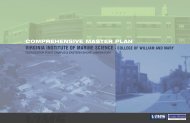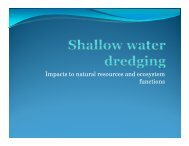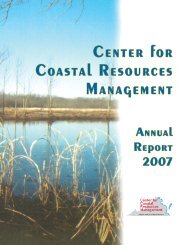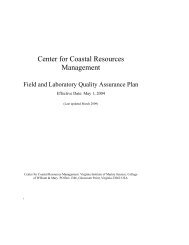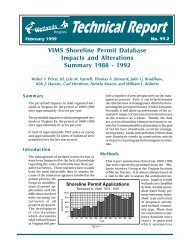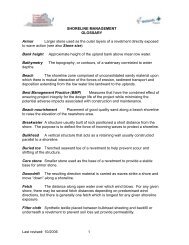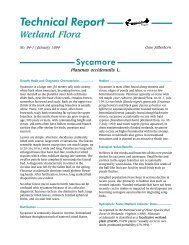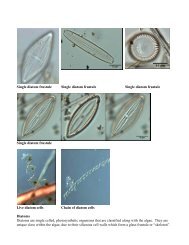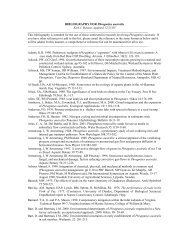Report - Center for Coastal Resources Management - Virginia ...
Report - Center for Coastal Resources Management - Virginia ...
Report - Center for Coastal Resources Management - Virginia ...
You also want an ePaper? Increase the reach of your titles
YUMPU automatically turns print PDFs into web optimized ePapers that Google loves.
Chapter 4. The Shoreline Situation<br />
The shoreline situation is described <strong>for</strong> conditions in the City of<br />
Poquoson along its primary and secondary waterways. Characteristics are<br />
described <strong>for</strong> all navigable tidal waterways contiguous to these larger waterways.<br />
A total of 168.51 miles of shoreline are described. Sixty-two and one half miles<br />
were surveyed in the field. The remaining 106 miles are described using image<br />
interpretation techniques and ancillary data sources. These areas are dominated<br />
by the extensive network of tidal channels through salt marsh habitat. Photo<br />
interpretation was made using DOQQs to detect land use, natural buffers, and<br />
shoreline structures. Along the tidal channels and main shoreline of Big Salt<br />
Marsh, upland banks are assumed to be well protected by expansive salt marshes<br />
and tidal flats. The marsh edges are assumed to be relatively stable within the<br />
tidal channels, but undergoing erosion on the more exposed Chesapeake Bay<br />
shore side. Bank height conditions along reaches characterized using remote<br />
sensing techniques were estimated from USGS 1:24,000 topographic maps.<br />
Riprap protects the low-lying residential district in Lambs Creek.<br />
Brief descriptions of the city are provided on the basis of river segments,<br />
the boundaries of which are geographically determined. These descriptions<br />
summarize tabular data (Table 5) and notable features present. Three<br />
segments are defined. Segment 1 includes plates 1-2. Segment 2 includes<br />
plates 3-5, and Segment 3, plates 6-7. An index preceding the map compositions<br />
illustrates the plate boundaries. Important documentation pertaining to<br />
each plate follows the segment description.<br />
Segment 1 (Plates 1-2)<br />
Description: Segment 1 begins at the city border running along the center line<br />
of the Poquoson River into Lambs Creek. This segment also extends through<br />
Bennet Creek to Lloyd Bay. All 55.11 miles of shoreline in Segment 1 were<br />
surveyed in June, 1999. Fringing marshes are common along much of the<br />
shoreline until Lloyd Bay, where embayed marsh is more common. Approximately<br />
one quarter of these marshes are characteristically erosional. Of the<br />
27.25 miles of marsh, 6.73 miles around Blackwalnut Ridge are eroding. While<br />
marshes are common in Segment 1, very few beaches are found. Only 0.03<br />
mile of beach exist along the shoreline of this segment.<br />
Land Use: Much of the shoreline in Segment 1 has been developed. Approximately<br />
42% of the surveyed miles are residential. Scrub-shrub comprises the<br />
majority of the remaining land cover, and dominates along Easton Cove and<br />
around Blackwalnut Ridge. Thirteen percent of the shoreline is <strong>for</strong>ested, and<br />
2% is commercial. When compared with statistics reported in Anderson<br />
et.al.(1975), land use has not changed extensively over the last 23 years.<br />
Bank Condition: Bank heights along this segment are all below 5 feet. The<br />
majority of these banks were classified as stable or low erosion, confirming that<br />
the extensive marshes offer significant protection to the upland bank. Of the<br />
55.11 miles of banks, 2.65 miles are characterized as high erosion. According<br />
to Anderson et.al. (1975), flood hazard potential is high and critical in this<br />
segment due to the extreme low elevation of the fastland. This segment is very<br />
susceptible to flooding from all predicted flood levels.<br />
Shore Condition: Erosion control structures are not uncommon along the<br />
residential dominated shoreline in Segment 1. Erosion from tidal current and<br />
Owens Marina in Bennett Creek.<br />
boat wakes are suspected to be the principal cause <strong>for</strong> shoreline erosion. There<br />
is 7.58 miles of riprap and 3.29 miles of bulkhead. Pier density is high in this<br />
segment as well. The historical erosion rates reported in Byrne and Anderson<br />
(1983) <strong>for</strong> the reaches within this segment are minimal (SSR).<br />
Segment 2 (Plates 3-5)<br />
Description: Segment 2 covers Lloyd Bay, Cow Island, Big Salt Marsh, around<br />
Plumtree Point to Bells Oyster Gut. Almost all (97.8%) of the upland is protected<br />
by wide embayed marshes. A total of 103.34 miles of shoreline in this<br />
segment were surveyed. A significant portion of this shoreline was surveyed<br />
remotely (plates 4 and 5). Data collection in the field which did occur took<br />
place in June, 1999 (plate 3). Much of the primary shoreline is adjacent to or<br />
along the mainstem of the Chesapeake Bay. Shallow nearshore depths due to



